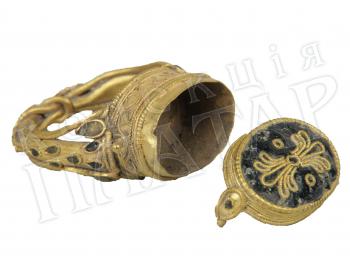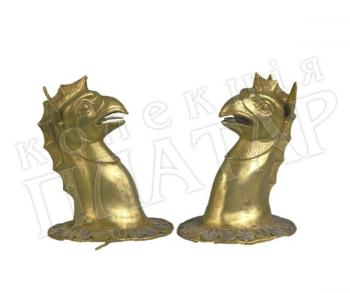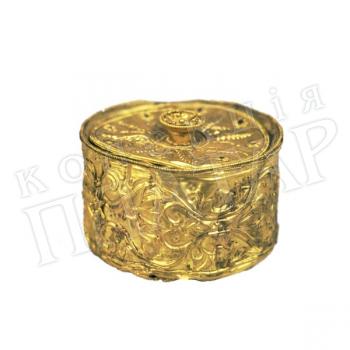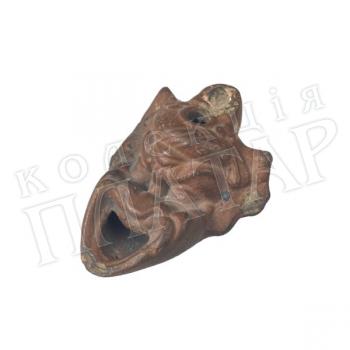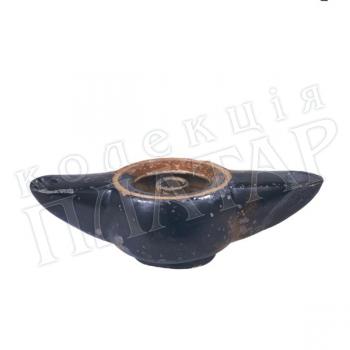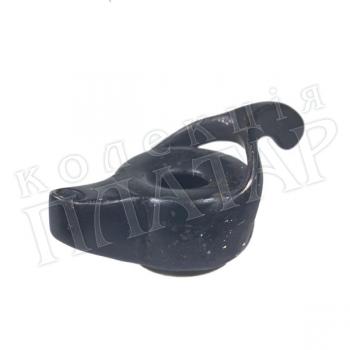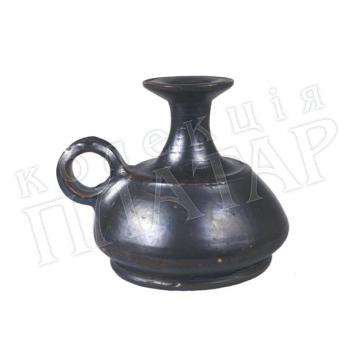Finger-ring with oval shield-box with miniature fastener and paste mounting of wire double rosette on the front side. Side part of the shield is pictured with belts of twisted, smooth and ribbed wires and ornamental pattern in a form of egg-like curl.
Greek and Roman time
Settlement of Pontus Euxinus shores by Hellenes, who called it the Hospitable sea, was one of the directions of the Great Greek colonization. At that time the territory next to the Northern part of the Black sea territories was considered a distant part of the world. According to an idea of ancient Hellenes an entrances to the Subterranean kingdom. Legendary tales about the cruel, ruthless Scythians, Tauri, who sacrificed travelers, who would fall into their hands, obviously, have real foundation. Cold climate of these places was unusual for ancient Hellenes. Nevertheless this region attracted colonists by minerals, fertile soils and possibility of getting income from trade with local population.
For the first time the Hellenes — ancient Greeks — have appeared on the Northern banks of the Pontus at the XI–X cent. B.C. Memoirs concerning such expeditions remained in the form of myths in eposes “The Argonauts’ navigation” and “The Odyssey”.
At the half of VII cent. B.C. Milesians — citizens of Greek city at the territory of the Asia Minor — have founded first colonies-trading stations in the Northern part of the Black sea territories. At VI–V cent. B.C. on the Northern bank of the Pontus such Greek centers functioned: the Olbia, the Chersonese Tauri, the Panticapaeum, the Phanagoria and others. Their founders were representatives of different cities, which had their own specialties of social and political system. Residential population of the Northern part of the Black sea territories — the Scythians, the Tauri, the Sindi, the Maeotae and other peoples who populated this region — had different social and political organization and culture. After Greek colonists appeared a process of interaction between the Hellene and barbarian cultures started, it was not homogeneous and depended a lot on local peculiarities, typical for some regions of the Pontus.
In V–IV cent. B.C. at the Northern part of the Black sea main Hellene state formations have been created: the Olbia state (the North-Western part of the Black sea territory), the Chersonese state (the North-Western Crimea) and the Bosporus state (the Eastern Crimea, territory of the Taman Peninsula and the Northern Caucasus). This period is characterized by growth of Greek cities’ economy and increase of population. The formation of the Pontus Hellenes cultural commonality started. The catalyst for this process was the Athens state, which influence in the Black Sea region was very considerable from the middle of the V cent. B.C.
A great role in subsequent fate of the Greek centers in the North-Western part of the Black sea territory was played by consolidation of the two biggest Barbarian formations: the Scythian and Thracian kingdom, which carried out an aggressive policy to their neighbors. Situation became pointed after appearance of the Black sea territory of the Sarmatians tribes in the North-Western part at II cent. B.C. The Hellene epoch (IV–I cent. B.C.) was characterized by permanent conflicts between Barbarian kingdoms and Hellenes.
At II–I. B.C. city states of the North-Western part of the Black sea territory belonged to the Pontus kingdom of the Mithridates VI the Yevpator. This association became corollary of all preceding development, which lasted in the line of creation of a single political and economic commonness in this region. Since then Greek centers lose their political independence finally completely. The purpose of the Mithridates was creating of a world Orient Greek state. The main obstacle of it was Rome. The Pontus kingdom has lost war with this enemy.
From I cent. B.C. Greek cities became fully dependent on Roman politics. At the Olbia and Chersonese Roman garrisons were situated. History of the Bosporus state in this period of time was characterized with extreme instability and dependence on situation in Rome. Along with political changes alterations in cultural life of the Pontus’ Hellenes took place. Under local elements showed through Greek covering, which was seen in peculiarities of political and economical systems, culture and religion.
This period gets its name from political and cultural leadership of the time of Roman republic and then — the Empire. Roman conquest at the B.C. boundary has reached the Iran limits in the East; Syria, Judea and Egypt became Roman provinces. After creation in year 23 B.C. of the Low Mesia province on the territory of present Romania only the Danube separated lands of the Empire and the Black Sea barbarians — the Sarmatians and later Scythians. In the sphere of political and economic interests of Rome appeared antique states of the North-Western part of the Black sea territory.
Roman invasion to the North-Western part of the Black sea territory practically was military occupation. The Chersonese which had perfect harbor and was a sea outpost of the Crimea in general, became the main Roman forces’ base station. Next to it, at the cape Ay–Todor Romans have built the Hyrax fortress. There was a Roman garrison even at the late Scythian Palakhiy (the Ust–Almenske site of ancient settlement).
After the defeat of the Mithridates VI Evpator during a war with Rome the Bosporus state was practically independent at the beginning. But soon political interests of the Empire reached these distant lands. In year 49 A.D. emperor Claudius helped Cotis I to seize the Bosporus throne from his brother the Mithridates VIII. Since then the Bosporus king named himself a “Roman friend”, and before his name as a sign of respect put Roman dynastic “Tiberius Julius”. But the Bosporus did not become a province, it was still subordinated to Rome only nominally.
In the middle of I cent. B.C. the Olbia was burned by the Hittite king Burebista. That’s why after Roman times it almost lost its meaning of a strong center of the Greek culture and turned to a small settlement. Its territory reduced practically three times. The Olbian state retained self-governance, although from 60th to the beginning of 80th of I cent. A.D. It was under nominal power of the Sarmatian kings Harzoy and Inismey, who mint their coins at the Olbia. In the middle of II cent A.D. Tira, Olvia and Chersonese were embraced by the Low Mesia province. But it was harder and harder for the atonic Empire to control remote eastern areas so in the third quarter of III cent A.D. Roman forces were evacuated from the Northern bank of Pontus Euxinus.
The end of the Roman epoch was related with the creation on territories of the present right–bank Ukraine and Moldova of the Ermanaric Goth kingdom (the second half of III cent. A.D.). At 375 year the Hun invasion reached ancient cities of the region. Olbia couldn’t rise after it, and in Chersonese and Panticapaeum life haven’t stopped. Soon both cities became part of the Byzantium Empire.
The proper Latin culture did not penetrate ancient centers of the North-Western part of the Black sea territory. Almost all of them remain Hellene according to their life, language and culture. Hellene traditions were respected the most by Olbia, where in year 95 A.D. according to the testimony of the Vifium rhetorician Dion the Chrisostomaus, loved and knew Homer by heart, rated Platoon highly and treated contemptuously those who showed benevolence to Rome. The Chersonese and Tira faced more Romanization.
At the Roman time in material culture of ancient centers of the region were extended items, which were vogue in the Empire. Instead of traditional Greek–made black–varnished ceramics pots from Asia Minor and then workshops of Italy, Gaul, Thrace started to produce crockery, covered with bright red or orange varnish which was called ‘terra sigillata’. After the invention of blowing technology glass-ware production was easier and it became usual in use by Romans and their neighbors. Along with crockery made of transparent glass were used costly goblets and cups from color or mosaic glass of ‘millefiori’ style which brims sometimes were fettered with gold. Production and application of bronze and silver crockery was spread. In jewellery polychrome style with precious jewels, color minerals and glass was used instead of whole gold furnishings of classical and Hellenes style. Jewelry get delicacy and brightness, became more exquisite because of wide use of granulation, filigree and encrustation techniques. Polychrome style came from Near East countries and, obviously, leading jewellery centers became cities of Syria and Egypt. Roman culture feature became a popularity of little metal and bone plastics. Silver and bronze statues of gods and heroes were used in religious rituals or stood at home sanctuary. Interiors of prosperous houses were decorated with cast miniature lions, panthers, deers, eagles and horses.
Material culture of ancient cities of the North-Western part of the Black sea territory reflects fully changes in fashion of the civilized world of that time. Red-varnished or colorless glass-wear became usual for Olbia, Chersonese and Tyra inhabitants’ use. But remoteness of the Black sea cities form the mother country was the reason of absence of costly ‘millefiori’ crockery or silver and bronze foodware. Extremely interesting are jewellery of the North-Western part of the Black sea territory in the Roman period. According to stylistic features they imitate East Mediterranean polychromy of late Hellenism, and at that time in Rome and western provinces other style was predominant, where green (emerald or glass) insets were made on a whole gold background. It is not inconceivable that most costly furnishings were made by Bosporus or Chersonese jewelers by Alexandria or Syria models.
At the end of Roman age cultural and economical relations of ancient cities of the North-Western part of the Black sea territory were mostly oriented to the eastern part of the Empire, which soon turned to Byzantium.









